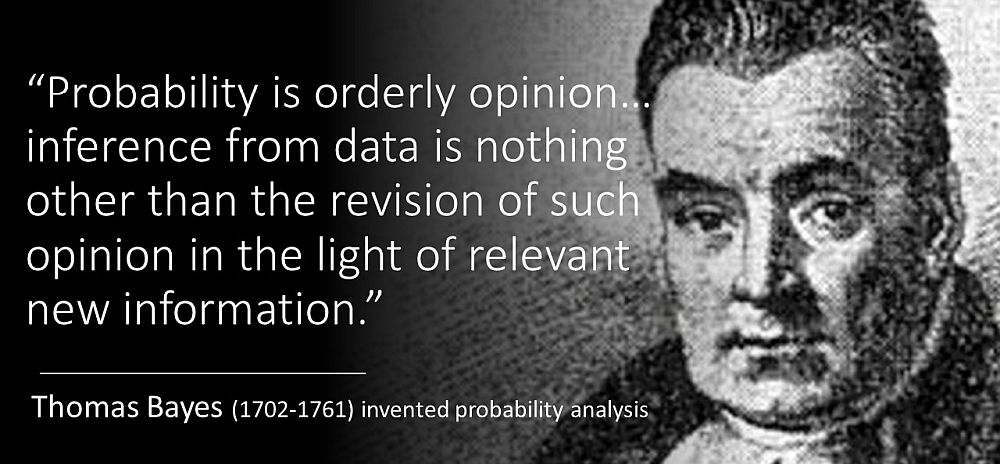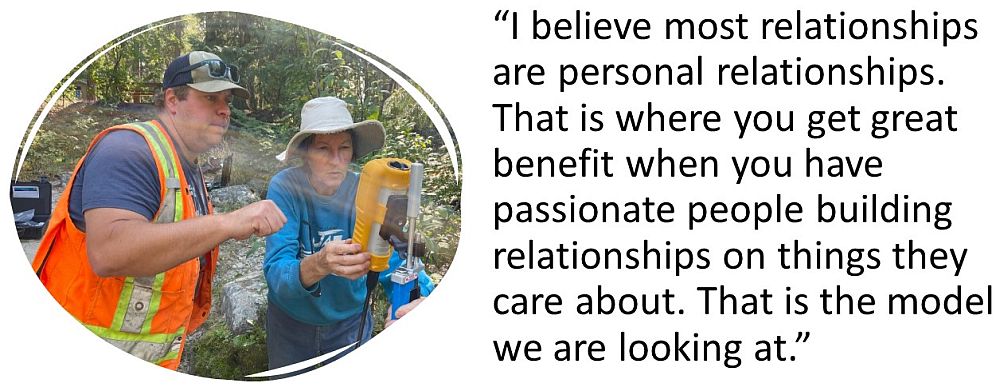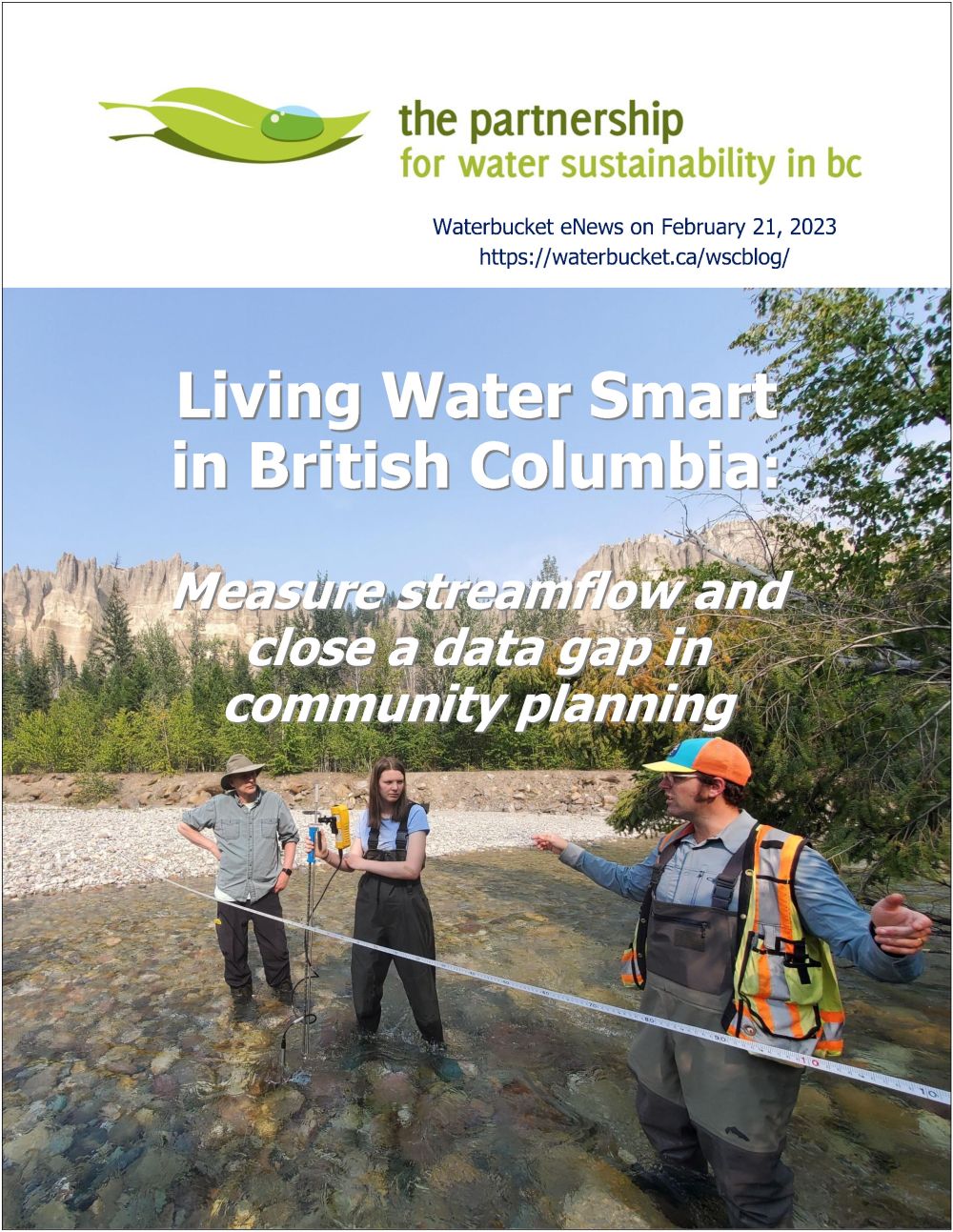MEASURE STREAMFLOW AND CLOSE A DATA GAP IN COMMUNITY PLANNING: “My vision is to develop relationships and partnerships with stewardship groups, local governments, federal government and First Nations to expand our collection and understanding of data,” stated Neil Goeller, Ministry of Environment & Climate Change Strategy
NOTE TO READER:
Waterbucket eNews celebrates the leadership of individuals and organizations who are guided by the Living Water Smart vision. The edition published on on February 21, 2023 featured a provincial government initiative to mobilize stewardship groups and community volunteers to collect streamflow data in small creek systems where flow data are sparse to non-existent.

Neil Goeller has created a self-fulfilling prophecy with a provincial program that teaches and coaches stream stewards across B.C. to measure streamflow and close a data gap in community planning
Understanding the complex interactions of whole-system, water balance processes that lead to water availability in and on the ground, and all the values that depend on it, is critical to effective water resource allocation or management to support land use and community planning that also sustains stream systems.
The provincial government leads the way at the macro-scale with collection, storage and dissemination of surface and groundwater data for resource management. A federal agreement provides for larger scale data collection on major sources (rivers and lakes). However, there is a gap at the local scale where water-centric land planning depends on having reliable streamflow data.
First Nations and stewardship groups have intimate knowledge about local water resources. They are the most invested and most connected to the land base. Involvement of stream stewards in streamflow data collection is a way to educate them about creekshed hydrology, in particular correct data collection and processing techniques.
Building stewardship sector capacity to support local and provincial planning and resource management processes would enhance the effectiveness of stream stewards as champions for reconnecting hydrology and ecology in settled areas. It would also fill a gap in small creek systems where flow data are sparse to non-existent.
Closing the Data Gap: Water Stewards, the Key to the Future
A provincial government initiative led by Neil Goeller is mobilizing stewardship groups and community volunteers to collect such data. This self-fulfilling prophecy is an idea that was seeded as a workshop module within the Parksville 2019 program, the second in the Watershed Moments Symposia Series on Water Stewardship in a Changing Climate. The program also reaches out to First Nations communities.
“It requires a long-term commitment to build stewardship sector capacity to do flow measurement,” says Neil Goeller. “It is also a word-of-mouth process to expand participation in the initiative. That was the value of the Parksville 2019 Symposium – it raised awareness and encouraged volunteers to get involved. I see this as a slow and steady, organic process to grow the collaboration.”

In conjunction with the Parksville 2019 Symposium, Neil Goeller demonstrated and provided hands-on training for flow measurement.
EDITOR’S PERSPECTIVE / CONTEXT FOR BUSY READER
“Neil Goeller is the Unit Head responsible for Groundwater, Hydrometrics and Hydrology Programs at the Ministry of Environment and Climate Change Strategy. His story behind the story complements that of Dr. John Millson who we featured on February 14, 2023,” stated Kim Stephens, Waterbucket eNews Editor and Partnership Executive Director.
“A takeaway message common to both stories is how stream stewards can collaborate with governments and resource managers to support a science-based approach that interweaves Indigenous knowledge to educate the population writ large about the fragile nature of the “water balance” in local creeksheds.”
“Neil Goeller brings a provincial government perspective to the Watershed Moments team. He had an idea for building stewardship capacity, and with the energy generated by the Parksville 2019 Symposium, he successfully brought the idea to fruition as a provincial program.”
“When I interviewed Neil about the story behind his successful initiative, three key ideas emerged. Suffice to say, Neil is passionate about collaboration with stream stewards. Within his “story behind the story”, I believe Neil Goeller has seeded the idea for a second self-fulfilling prophecy!”
Indigenous knowledge helps us make sense of the hydrology numbers
“In my mind, traditional knowledge and western science are just different ways of recording, or documenting, and communicating the same information. I believe there is an analogy between Indigenous oral history, and a statistical approach called Bayesian analysis,” Neil Goeller stated during a conversation with Michael Blackstock in 2022 about Blue Ecology.
“In BC, we are lucky when we have 60 years of reliable records, possibly extending out to 100-plus years. When I reflect on the short-term context for hydrometric data collection in this province, there is no doubt in my mind that Indigenous knowledge would expand our horizon and help us make sense of the numbers in a larger context,” he concluded.
STORY BEHIND THE STORY: Measure streamflow and close a data gap in community planning – conversational interview with Neil Goeller
“It is an exciting time to be responsible for hydrometric data collection in British Columbia. The Ministry of Environment and Climate Change Strategy has received new funding to build a team and distribute hydrometric technicians across the province to train and mentor stewardship groups, First Nations, and internal staff regarding hydrometric operation. Within three years we will have a team of twelve,” says Neil Goeller. His enthusiasm comes through as a tsunami.
“The Province is looking for opportunities to improve the base of information that informs decisions related to land and resource planning. And stewardship groups provide a great opportunity to produce that kind of information. We can train them. And as we build their capacity and they become self-sufficient, maybe we can be less and less involved in their operation.”

KEY IDEA ONE: Water-first Community Planning – We can improve the base of information that informs land and water decisions at the micro-scale
“A funding uplift from the Climate Preparedness and Adaptation Strategy means the Ministry can begin to meet a provincial need. There are three elements: expansion of the groundwater observation network; expansion of the co-managed federal-provincial Water Survey of Canada hydrometric network; and establishment of a provincial hydrometric network at the creekshed micro-scale where flow data are sparse to non-existent.”
“We were lucky to get Jon Jeffery from Water Survey of Canada in Calgary. He joined us in 2021. He was originally hired to develop hydrometric training. He took to it like the proverbial hydrometrist to water and has nearly built a complete training program. The objective is to get stream stewards into what I call a manageable scope.”
“We would love to turn Jon’s training into some form of certification. It would be great to deliver seminars and recognize folks as data collectors and data reviewers. Getting out in the field to do data collection is expensive. So, it would be good to have third party groups doing it.”
“Jon is already out there building relationships and we want our new staff out there too. It is TEACHING AND COACHING. People who are new to it, we can teach them. People who have existing networks, it is more of an audit or coaching process. We go out in the field with them, see what they are doing, and provide feedback on ways to improve data collection. The intention is to bring data collection up to the provincial standard.”
“Jon has the training figured out. It has been a deliver and refine method. Jon developed the training curriculum and tested it with various groups in different regions of the province. Now we are talking about making videos of practical demonstrations of data collection.”
KEY IDEA TWO: Hydrology is NOT an exact science – How certain are you about your numbers?
“When it comes to measuring streamflow, there is a real risk of groups or individuals or ministries out-sourcing work that they do not understand. For this reason, a program goal is to educate these groups so that they get value for the dollar when work is done for them by third parties.”
“It is a process to teach them what hydrology looks like, and what hydrometrics look like. There are so many aspects to it – how do you collect this data, what does it look like when you collect it, what is the value of the data, and what do you do with the data once you have it. So many questions.”

“Hydrology is NOT an exact science. Few people understand that. My cautionary tale is, be wary of anybody who gives a definitive or precise answer about their hydrological analysis. In my experience, they may be trying to pull the shirt over your head.”
“There may not be malicious intent to mislead, just not complete presentation of the data or incomplete analysis. At university I did not get a great education in quantifying uncertainty, who does?. But a complete answer is the estimate and its boundaries, so our audience fully understands the limits of prediction or calculation.”
KEY IDEA THREE: A stewardship conference for peer-based learning about closing the data gap – Could this be the next self-fulfilling prophecy?
“Eventually I would like to organize a provincial conference for stewardship groups who are doing streamflow data collection in different regions. It would bring together people with an interest in environmental issues, passion and skills to effect change.”
“My vision is that these non-professional groups would share stories about the work that they have done to close the data gap, successes and failures that they have had, why things worked or not, and where they can get the money to do the work.”

“And I would also like to bring in people from the funding organizations to explain how their funding works, the sort of things they are looking for, what sort of projects they want to fund, and how they could get involved.”
“And after that, it would be great to provide some level of organization and coordination where people can see what sort of work is happening around the province. The desired outcome is that these groups would develop work plans that have flexibility to adjust to, and make timely use of, grant funding as and when it becomes available.”
“When I reflect on what is needed, I believe stewardship groups would benefit from the experience and wisdom of a financial management stewardship group. This group would not have to do the work. They could, for example, be retired bankers. Or retired project managers who know how to wrangle with contractors. You leverage the different passions for people to do the work,” concludes Neil Goeller.
TO LEARN MORE:
To read the complete story published on February 14th 2023, download a PDF copy of Living Water Smart in British Columbia: Measure streamflow and close a data gap in community planning.

DOWNLOAD A COPY: https://waterbucket.ca/wcp/wp-content/uploads/sites/6/2023/02/PWSBC_Living-Water-Smart_close-data-gap-at-local-scale_2023.pdf

